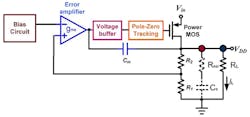This article is in TechXchange: Why Low Iq is the Smart Thing to Do
Members can download this article in PDF format.
What you'll learn:
- Leveraging a 180-nm CMOS process for improved energy efficiency.
- Using an RF front-end in an implant.
- The MISCHIEF platform that employs a ULP PMIC.
The active implantable, subcutaneous medical-device market is growing significantly, mainly attributed to the expanding senior population and subsequent increase in cardiovascular and neurological diseases that plagues this age segment. Low quiescent current (IQ) is crucial in these implanted devices, so that users will not have to interrupt their lives too often to recharge the device.
Neurostimulators also are used to provide forms of sensory perception. One example is the cochlear implant, where electrical stimulation of auditory neurons, using electrodes implanted in the cochlea, can provide hearing sensations to people with a severe, profound, hearing impairment.
Extending battery life in future devices will require mastery of low IQ within the design architecture. Let’s look at some methods to design these devices with low IQ in mind.
Taking Advantage of the CMOS Semiconductor Process
ICs fabricated on a 180-nm CMOS process can achieve a quiescent-current consumption of 1.8 µA (see Reference 1). The energy efficiency (useful energy output/energy input) can ideally approach unity when the averaged stimulation current is much higher than the quiescent-current consumption of the ICs.
One working example of the above-mentioned efficiency circuitry is a switched-capacitor-based stimulator circuit that enables efficient energy harvesting for neurostimulation applications. The stimulator can salvage input energy and store it in a storage capacitor. When the voltage reaches a certain threshold, the capacitor will release the energy as an output stimulus.
Thanks to the low-power feature of this kind of device, the stimulator could potentially be implanted into more otherwise inaccessible areas in the body.
Low-Power RF Front-End for Implantable Devices
This case involves a low-power, fully integrated CMOS RF front-end circuit for a passive 13.56-MHz biomedical implant.
The design of a linear regulator, with low IQ and unconditional stability and no output capacitor, is a key part of this design architecture (see figure). The linear regulator is designed based on unconditional stability without the output capacitor. The need for a low IQ is to reduce transmission power and supply more energy for the back-end circuitry.
As shown in the figure, the regulator includes a bias circuit, an error amplifier, a voltage buffer, a pole-zero tracker, a power MOS, and a Miller capacitor (Cm ) as a feedback element. The circuit is fabricated on a TSMC 0.18-µm CMOS process.
The quiescent current for this linear regulator design is just 16.7 µA .
Ultra-Low-Power (ULP) Energy-Harvesting PMIC
ULP PMICs have low bandwidth and low average data “battery-less” (maintenance-free) systems, or battery life in excess of 25+ years.
For instance, the MISCHIEF platform being developed by Tyndall National Institute (Cork, Ireland) is a high-efficiency, low IQ (200-nW quiescent power) PMIC that can handle an amazing range of ambient energies, especially in the sub-10-μW domain. The device’s digital interface enables it to interact with other components to dynamically adjust their operation mode (sleep, standby, sense, transmit, process). This will minimize their power consumption and still meet application needs.
The MISCHIEF test IC is expected to lead to energy-harvesting IP block devices for improved medical implantables. Cardiac pacemakers may be able to be powered by harvesting the natural energy of a heart beating.
Summary
Medical implantables, with low IQ devices on board, will make life so much easier for the patient. Longer times between charging these implanted medical electronics devices are attributed to excellent low-power IC designs within these implants. ULP energy-harvesting PMICs also make quite a difference in these device applications within the human body.
Read more articles in TechXchange: Why Low Iq is the Smart Thing to Do
References
1. “An Energy-Efficient Wirelessly Powered Millimeter-Scale Neurostimulator Implant Based on Systematic Codesign of an Inductive Loop Antenna and a Custom Rectifier,” IEEE Transactions on Biomedical Circuits and Systems, Vol. 12, No. 5, October 2018.
2. “A Low-Power 13.56 MHz RF Front-End Circuit for Implantable Biomedical Devices,” IEEE Transactions on Biomedical Circuits and Systems, Vol. 7, No. 3, June 2013.
3. “Energy Harvesting ULP PMIC for Smart Sensor Node,” Tyndall National Institute.

